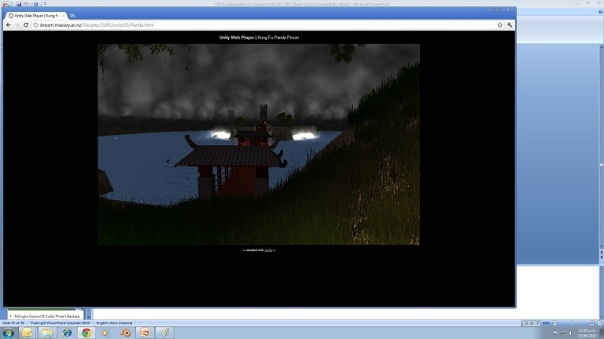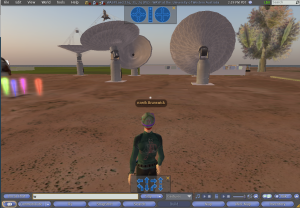The WOW! Factor
By Virginia Winder –Taranaki Daily News
Last updated 11:11 29/07/2009
The Forbidden City is virtually empty. Chinese tour guides, wearing red traditional costumes, wait for visitors.
 Chinese tour guides, wearing red traditional costumes, wait for visitors. An Imperial woman glides past the guides and through the Meridian Gates to explore the city alone. Every now and then she passes an official attendant or another tourist, whose meaningless name floats above his or her head like a sign. For a few seconds, someone with a number for a name and dressed as an Imperial guard circles the woman, then slides away.
Chinese tour guides, wearing red traditional costumes, wait for visitors. An Imperial woman glides past the guides and through the Meridian Gates to explore the city alone. Every now and then she passes an official attendant or another tourist, whose meaningless name floats above his or her head like a sign. For a few seconds, someone with a number for a name and dressed as an Imperial guard circles the woman, then slides away.
Our woman joins a quick tour about dragon architecture and finds herself in an outer area where archers are practising. She quits the tour, checks the map and winds her way through to the Hall of Mental Cultivation and gets lost in time and the detail of the buildings. All this is accompanied by the sweet swirling sounds of Chinese music. For this is not a real tour, but an IBM-created journey that can be downloaded for free anywhere in the world.
Erik Champion, Massey University associate professor of new media, recommends having a look at the virtual Forbidden City, because it shows how much work is involved with his area of interest and expertise: virtual heritage design.
Champion, based at Massey’s Auckland School of Design at Albany, says the virtual world is not just the domain of games. He believes software developed for gaming holds huge potential.
In his research and teaching, Champion has used digital tools to create websites and interactive games on Mayan civilisation, Marco Polo’s travels and Egyptian gods. He prefers people to roam freely. “People get bored with tours – they’re probably too passive for people. I’d like to design a personally discoverable world where you can choose the interactions, the way in which you approach the site and the way you are viewed by others.”
This would be game-like, but with more intellectual outcomes. He also talks of “augmented reality” and “biofeedback”. The first relates to physically visiting a site wearing special glasses that would enable drop- down graphics to appear in your field of vision and these would change and be refreshed as you turned your head. They are being developed and used at Canterbury University’s HIT Lab, where researchers are working on interaction between computers and humans. Champion envisages using augmented reality to see the past.
“If you were standing on a sacred site, what used to be there would appear on your glasses, or maybe it would be projected on to fog between you and the real site.
“Imagine seeing the Pink and White Terraces or the spirit trails of ancestors leaving Cape Reinga – all these things we don’t normally see.”
Champion wants to help New Zealanders tell their own stories.
“I would like to create the tools and technologies so local people could design it [the world or vision] themselves.”
He’s even keen to teach people 3D, animation and programming skills so they can go forth and create using advanced tools like curved mirrors, screen warping and biofeedback receptors. If a person is playing a game or visiting a heritage site with biofeedback, physiological reactions like pulse, skin temperature and sweat can be measured by a computer, perhaps even unknowingly through a joystick or mouse.
Champion cites a New Age meditation journey, which induces people to become calmer. This is the opposite of a zombie game recently tested by a PhD student. In that game, the more stressed the player became, the more the living dead attacked the avatar (the character or identity you become when playing a game or entering a virtual situation – like the tourist became a Chinese Imperial woman).
Biofeedback holds exciting possibilities for learning about other civilisations and even religions, Champion says.
He likes the idea of using it to affect people’s states of mind in a virtual environment. However, he would prefer people got feedback that helped them stay calm. “The more calm you are, the more the world becomes obvious to you. And the more reflective you are, the more interesting things will happen.”
Champion says it would be possible to create a virtual Buddhist temple with biofeedback.
“Only when you really calm down and really slow down will you discover things.”
He imagines the avatar would levitate or have great wisdom revealed.
“It’s a bit like interactive cinema.”
Another idea he’s been working on involves people having to learn to be like the locals. This is the inverse of the Turing test (see Freaky Facts) and involves a person in a virtual world trying to convince the scripted characters he or she is an artificial intelligence like they are.
“That way the test is on you, the human, not the computer. Why would you want to do that? Because then the human players have to learn to act like the locals and learn the culturally appropriate way of behaving.”
By proving they are not imposters, the human player would learn all about the customs, history and stories of the virtual world. This would be particularly valuable if it were a heritage environment.
“You could create an inter- cultural language game whereby if you say different words correctly, things appear to you as they did to different cultures.”
Champion has just returned from a Fulbright-funded study trip to the United States, where he presented his virtual environment research at many universities, including Harvard, Stanford and the Massachusetts Institute of Technology.
Now Champion is seeking more post-graduate students to help develop software and their own ideas. The Forbidden City link is http://www.beyondspaceandtime.org/FCBSTWeb/web/index.html#link=



